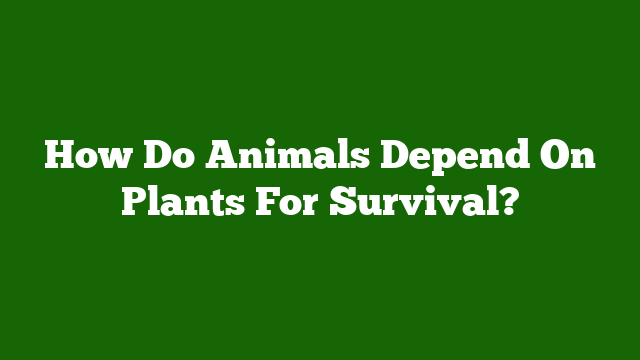Last Updated on June 12, 2023 by Umar
Animals and plants share a complex and interconnected relationship that is essential for the survival of both groups.
This guide will provide a comprehensive understanding of the various ways animals depend on plants for their survival, including food, shelter, reproduction, and the role of plants in the ecosystem.
Food and Energy
At the core of the relationship between animals and plants is the need for food and energy.
Green plants are the primary producers in ecosystems, as they can produce their own food through the process of photosynthesis
This process allows plants to convert sunlight, carbon dioxide, and water into glucose, which serves as an energy source for the plant.
In addition, photosynthesis releases oxygen, which is essential for the survival of animals
.
Animals, on the other hand, are consumers and depend on plants for their food and energy needs.
Herbivores, such as deer and rabbits, directly consume plants, while carnivores, like lions and wolves, eat other animals that have consumed plants
Omnivores, like humans and bears, consume both plants and animals for their energy needs
.
Shelter and Habitat
Plants play a crucial role in providing shelter and habitat for animals.
A habitat is a place where an organism makes its home and meets all the environmental conditions it needs to survive
For animals, this means finding food, mates, and suitable living conditions.
For plants, a good habitat must provide the right combination of light, air, water, and soil
.
Different types of habitats, such as forests, deserts, and wetlands, support diverse plant and animal communities.
For example, the prickly pear cactus thrives in desert areas like the Sonoran Desert, providing shelter and food for animals such as desert tortoises and bighorn sheep
In turn, these animals help disperse the seeds of the cactus, ensuring the survival of both the plant and the animal species
.
Pollination and Reproduction
Many plants depend on animals for pollination, which is essential for their reproduction
Insects, birds, and even bats play a crucial role in perpetuating plant species by transferring pollen from one flower to another.
This process, known as cross-pollination, allows plants to produce seeds and fruits, which are then consumed by animals
.
In return, animals benefit from the nectar and fruits provided by the plants, which serve as food sources.
This mutualistic relationship between plants and their pollinators has led to the coevolution of both groups, with plants evolving specific traits to attract their preferred pollinators and animals adapting to better access the resources provided by plants
.
Ecosystem Balance and Food Webs
Plants and animals are integral components of ecosystems, with their interactions forming complex food webs that maintain the balance of energy and nutrients within the system
Food webs consist of multiple interconnected food chains, with each organism occupying a specific trophic level or position in the chain
.
Producers, such as plants, form the base of the trophic pyramid, providing energy and nutrients for primary consumers (herbivores), which are then consumed by secondary and tertiary consumers (carnivores and omnivores)
Apex predators, like eagles and sharks, occupy the top of the food chain and help maintain the balance of the ecosystem by controlling the populations of their prey
.
Decomposers, like bacteria and fungi, break down dead plant and animal matter, recycling nutrients back into the ecosystem and providing resources for new plant growth
This continuous cycle of energy and nutrient transfer ensures the survival of both plants and animals within the ecosystem.
Conclusion
The intricate relationship between plants and animals is essential for the survival of both groups and the overall health of ecosystems.
Through their roles as primary producers, shelter providers, and partners in pollination and reproduction, plants support the survival of countless animal species.
In turn, animals contribute to the dispersal of plant seeds, the maintenance of ecosystem balance, and the continuation of the cycle of energy and nutrients within the environment.
Understanding these complex interactions is crucial for the conservation and management of our planet’s diverse ecosystems.
Helpful Resources
- https://www.maine.gov/dacf/php/integrated_pest_management/school-ipm-curricula/elementary/documents/45_U3_S2_L2_Presto.pdf
- https://www.alaska.edu/k12reach/pdf-lessons/py3-pdfs/2-3/18_reach_23_how_do_plants_and_animals%20need_each_other.pdf
- https://www.nationalgeographic.org/topics/resource-library-food-chains-and-webs/
- https://www.nationalgeographic.org/encyclopedia/habitat/
- https://www.bbg.org/article/plant_animal_relationships
- https://education.nationalgeographic.org/resource/plant-and-animal-reproduction/8th-grade/
- https://www.nationalgeographic.org/encyclopedia/food-web/

